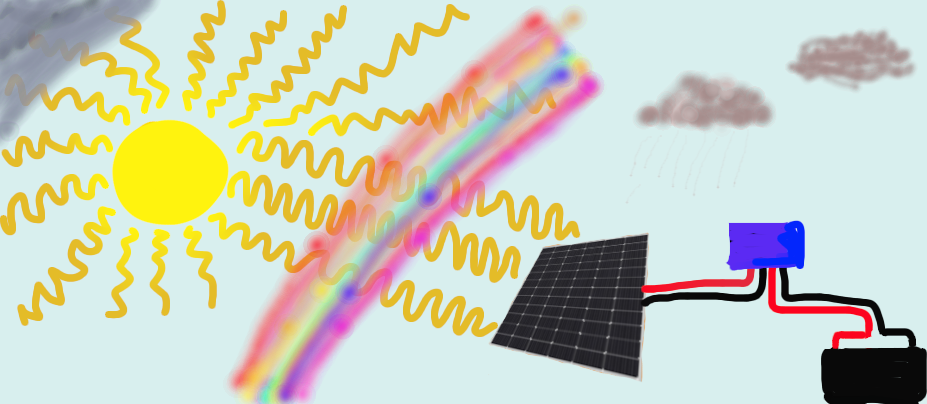
- Home
- Services
-
Catalogue
Autoelectrical Catalogue Alternators Alternator Parts Automotive Cables Batteries Battery Isolation Switches Battery Terminals Cable ties Cable Protection Conduit Connector terminals Crocodile Clips Fuses Fuseholders Inverters Jump Leads Ignition Parts Panel Indicator Lamps Relays and Flasher Units Starter Motors Switches and Switchgear Safety Equipment Towing Electrical Vehicle Alarms Voltage Droppers Wiring Tapes and Adhesives Wiring Tools
- About
- Terms
-
Contact
Solar Panels, Physics, and Free Green Sustainable Energy
Solar energy is advertised by many as a clean energy source in terms of being both sustainable and renewable with zero emissions. This is questionable when solar panel array banks are installed in agricultural fields which would otherwise have been used for food production. However in the case of vehicles and dwellings, solar energy systems offer many benefits proportional to scale including a low maintenance, off-grid electrical power source providing sustainable green energy.
Solar panels generate direct current (dc) electricity by converting energy from sun light which penetrates planet Earth's atmosphere.
The physics science of Radiometry indicates light is a form of electromagnetic radiation.
Light particles (photons) travel as waves, therefore having wavelength,frequency, and energy.
Light is on the electromagnetic spectrum with visible light falling between Infrared light and Ultraviolet light.
Different colours of light have different wavelengths. Red light (low energy) through visible light to Blue light (high energy). Rain droplets can reflect light and seperate the light in to different colours sometimes seen as a rainbow.
Photovoltaic (PV) semiconductor cells in each solar panel convert energy from sunlight solar radiation in to electricity. The construction materials specified in the solar panel manufacture contribute to efficiency and lifespan.
Efficiency of solar panels is maintained by keeping panels clean and free of excess dirt.
Solar Panel Array
Each Solar panel is made up of a number of photovoltaic cells.
Linking solar panels in series will generate increased voltage.
Linking solar panels in parallel will generate increased current.Diodes
Diodes are used in many electrical circuits effectively as a one way valve allowing current to pass in one direction but blocking a reverse flow of current subject to not exceeding preset voltage parameters. A blocking diode may be fitted to solar panel circuitry to prevent reverse flow of current from discharging battery at night.
Maximum Power Point Tracking (MPPT) Controller
An MPPT controller is connected between the solar panel array and batteries to control voltage output from the solar panels.
Pulse Width Modulated (PWM) Controller
PWM controllers are advantageous towards extending battery life and where multiple batteries need to be charged from the solar panel array.
Solar powered battery charging
To enable battery charging the output voltage of the solar panels via the MPPT controller must be above battery voltage
Solar panels are available as trickle charging units designed to keep vehicle batteries topped up with charge.
Electrical energy storage
A battery bank is used as a reservoir to store the electrical energy from the off grid solar charging system ready for later use. Individual battery cells are linked together in series to increase voltage. Linking battery cells in parallel increases current at rated voltage. The greater the storage capacity of the batteries, then the greater the amount of electrical energy that can be stored. Increasing battery capacity relates to increased weight of the battery bank which introduces constraints when considering vehicle applications. Furthermore, increasing battery capacity also increases the amount of electrical energy and time needed to fully charge the battery bank.
Inverter
An inverter is used to convert direct current (d.c) produced from by solar panels and stored in battery banks at low voltage, to alternating current (a.c.) and step up voltage suitably to power domestic mains electrical equipment
Semi-Flexible Solar Panels
Semi-Flexible solar panels are available for fitting to vehicle roofs which may have a curved profile
The semi-flex solar panels are bonded to the vehicle roof using an adhesive compound such as 'sikaflex' or similar.Frame mounted solar panels
Frame mounted solar panels are fixed to the vehicle roof using metal brackets and fasteners.
Truck mounted Solar Panels
Commercial vehicles may be fitted with solar panels as an aid to charging batteries, increasing efficiency and reducing fuel costs by saving engine power which would be used to drive the alternator to charge batteries.
Solar powered Welder?
As the mind wanders...all this 'free' electrical energy from the sun we have stored in our battery bank could be used to power an off-grid electric welding process, well temporarily anyway!
The key to specifying any battery powered system is calculating available power, efficiency of the equipment, amount of power being used, and the time needed to allow for recharging of batteries.
As the required storage capacity of batteries increases then generally so does the weight.